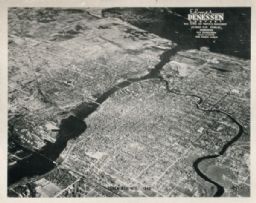Green Bay, Brown County
Origin of Green Bay, Wisconsin
A community in Brown Co. at latitude 443109N and longitude 0880111W; the county seat of Brown Co.
The earliest description of Green Bay is by Father Claude Dablon, who arrived there in the fall of 1670. Dablon's glowing tribute to Green Bay ranks as one of the best early descriptions of Wisconsin. Many tribes camped at Green Bay seasonally, but the area was (and still is) especially revered by the Ho-Chunk, who hold Red Banks as their place of origin.
Description from John W. Hunt's 1853 Wisconsin Gazetteer: "GREEN BAY, P. V. The village of Green Bay is an incorporated borough, comprising the town plats of both Navarino and Astor, the former being designated in the act of incorporation as the north, and the latter as the southwards. The town stands in the junction of the Fox and East rivers, on the east bank of the former, and about one mile above the mouth or entrance into Green Bay. The site of the town, although partly low and flat, is handsome and pleasant; the soil is alluvial, with large proportion of sand, which forms dry streets and walks, and proves most excellent for garden and cultivation. The present population of Green Bay proper is about 2,000, and is constantly increasing. The town is laid out with streets and alleys running at right angles. The corporation embraces a tract about one and a half miles in length on Fox river, and about one mile in width from east to west. The buildings are of wood, mostly frame, and many of them very neat and commodious as dwellings, stores, warehouses, offices, &c. The streets are generally of good width, and the lots larger than usually laid out in villages. Directly opposite, on the west shore of Fox river, stands Old Fort Howard, and the new and flourishing town of that name, lately laid out, and now containing a large number of houses, stores and inhabitants. The scenery around Green Bay and on the Fox river, is beautiful; the climate unsurpassed by any in the West for salubrity and healthfulness. It is even, and not subject to sudden change, as in many parts of the United States; and all kinds of fruits and vegetables capable of culture in the eastern, or northern or western States, are easily raised here, and most of them in great perfection and abundance. The bay and river abound with a vast variety of the finny tribe, of delicious and palatable flavor, and wild duck and other game are abundant. The winter season may be said to commence about the first of December, and continues with but slight change or variation, until about the middle or latter part of March. The Fox river is navigable, for six miles from its mouth, to Depere, for the largest class of steamers and vessels navigating the lakes. Its medium width between the two points mentioned is about 1,400 feet. The harbor at Green Bay is one of the most spacious and secure on the whole chain of lakes, and, as a natural one, it is next to Detroit. The geographical position of this place, situated as it is at the head of steamboat navigation on the lakes and upon the Fox river, connecting with the Wisconsin and Mississippi by canal, must necessarily be a commanding one, and it only requires the completion of the public work for the improvement of the Fox and Wisconsin river, to insure its permanent prosperity and future importance as a commercial and manufacturing depot. The principal articles of export from Green Bay and the surrounding country at the present time, are fish, lumber. shingles, and furs and peltries. ..."
Sparks from a steamboat set off a fire which destroyed over a hundred buildings in Green Bay on September 20, 1880.
Learn More
See more images, essays, newspapers and records about Green Bay, Wisconsin.
Dictionary of Wisconsin History
Explore more than 1,600 people, places and events in Wisconsin history.
[Source: U.S. Geographic Names Information Server]


